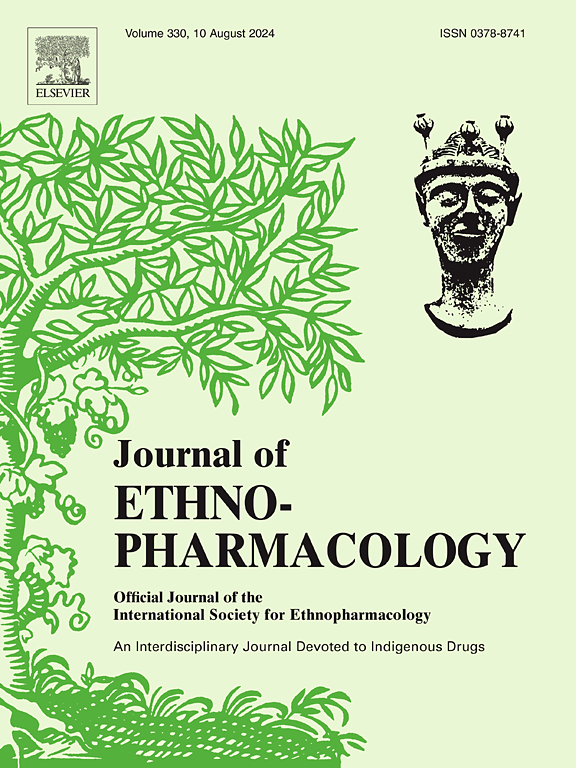Hyperacute intervention with DGMI for optimized stroke recovery: Modulating immune and inflammatory pathways in motor and sensory cortices
IF 4.8
2区 医学
Q1 CHEMISTRY, MEDICINAL
引用次数: 0
Abstract
Ethnopharmacological relevance
Long-term neurological dysfunction following stroke significantly impairs patients' quality of life. Ginkgo biloba L (GBL), a traditional Chinese herbal medicine, has shown promise in treating ischemic stroke and related disorders. Diterpene Ginkgolides Meglumine Injection (DGMI), derived from GBL, has demonstrated improved recovery outcomes in stroke patients when administered during the hyperacute phase (HAP) in clinical studies, yet the underlying mechanisms remain elusive.
Materials and methods
Utilizing a Transient Middle Cerebral Artery Occlusion (tMCAO) model, we evaluated the effects of DGMI at varying doses and administration times on neurological function, brain injury, and identified key genes/pathways via RNA-seq and bioinformatics analyses, validated by RT-PCR. An in vitro LPS-induced astrocyte activation model was used to evaluate DGMI's anti-inflammatory effects.
Results
DGMI administered during the hyperacute phase (HAP, 0.5 h post-tMCAO) exhibited superior neuroprotection compared to the acute phase (AP, 24 h post-tMCAO) in mice. HAP-DGMI significantly enhanced survival rates, reduced neurological deficit scores, infarct sizes, and neuronal apoptosis, with more pronounced improvements observed on days 3 and 7 post-tMCAO. Transcriptome sequencing revealed that HAP-DGMI more effectively normalized abnormal gene expression profiles, particularly in genes involved in immune and inflammatory pathways, in both motor (M1) and sensory (S1) cortices. Additionally, HAP-DGMI reversed a higher proportion of disease-characteristic pathways compared to AP.
Conclusions
These findings underscore the potential of early HAP intervention with DGMI in enhancing neuroprotection and functional recovery in AIS bymodulating key immune and inflammatory genes and pathways, providing experimental and theoretical support for the clinical application of DGMI.

用DGMI进行超急性干预以优化卒中恢复:调节运动和感觉皮质的免疫和炎症通路
脑卒中后长期神经功能障碍显著损害患者的生活质量。银杏叶(Ginkgo biloba L, GBL)是一种传统的中草药,在治疗缺血性脑卒中及相关疾病方面显示出良好的前景。从GBL衍生的二萜银杏内酯Meglumine注射液(DGMI)在临床研究中显示,在超急性期(HAP)给药可改善脑卒中患者的恢复结果,但其潜在机制尚不明确。材料和方法利用短暂性大脑中动脉闭塞(tMCAO)模型,我们评估了不同剂量和给药时间的DGMI对神经功能和脑损伤的影响,并通过RNA-seq和生物信息学分析确定了关键基因/途径,并通过RT-PCR验证。采用体外lps诱导星形胶质细胞活化模型评价DGMI的抗炎作用。结果dgmi在小鼠超急性期(HAP, tmcao后0.5 h)比急性期(AP, tmcao后24 h)表现出更好的神经保护作用。HAP-DGMI显著提高了生存率,降低了神经功能缺损评分、梗死面积和神经元凋亡,在tmcao后第3天和第7天观察到更明显的改善。转录组测序显示,HAP-DGMI更有效地规范了运动(M1)和感觉(S1)皮质中异常基因的表达谱,特别是涉及免疫和炎症途径的基因。与ap相比,HAP-DGMI逆转了更高比例的疾病特征通路。结论这些发现强调了早期HAP干预DGMI通过调节关键的免疫和炎症基因和通路来增强AIS的神经保护和功能恢复的潜力,为DGMI的临床应用提供了实验和理论支持。
本文章由计算机程序翻译,如有差异,请以英文原文为准。
求助全文
约1分钟内获得全文
求助全文
来源期刊

Journal of ethnopharmacology
医学-全科医学与补充医学
CiteScore
10.30
自引率
5.60%
发文量
967
审稿时长
77 days
期刊介绍:
The Journal of Ethnopharmacology is dedicated to the exchange of information and understandings about people''s use of plants, fungi, animals, microorganisms and minerals and their biological and pharmacological effects based on the principles established through international conventions. Early people confronted with illness and disease, discovered a wealth of useful therapeutic agents in the plant and animal kingdoms. The empirical knowledge of these medicinal substances and their toxic potential was passed on by oral tradition and sometimes recorded in herbals and other texts on materia medica. Many valuable drugs of today (e.g., atropine, ephedrine, tubocurarine, digoxin, reserpine) came into use through the study of indigenous remedies. Chemists continue to use plant-derived drugs (e.g., morphine, taxol, physostigmine, quinidine, emetine) as prototypes in their attempts to develop more effective and less toxic medicinals.
 求助内容:
求助内容: 应助结果提醒方式:
应助结果提醒方式:


